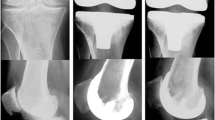Abstract
Between May 1984 and December 1988, 92 PCA Primary prostheses were fitted. In more than 80% of cases, the indication was primary degenerative arthritis of the knee, associated with genu varum in 70% of cases. In this study, 80 patients were reexamined and X-rayed (87% of operated cases) with a minimum three-year follow-up. Computerized analysis of data, according to Hungerford's 100 point score scale, showed good and excellent results in 81.2% of cases. 7.5% of all cases (6 cases) had to be reoperated on. Reasons for reoperation were aseptic tibial or patellar loosening, which occurred twice, and two replacements of prothesis. Analysis of this series confirms the very good clinical results achieved with this type of prosthesis. Representing the first type of prosthesis to be installed with the universal instruments, it makes it possible to preserve the posterior cruciate ligament, and, in most cases, the components were inserted and fixed without cement (70% of cases).
Résumé
Entre mai 1984 et décembre 1988, 92 prothèses PCA PRIMARY ont été mises en place. Il s'agissait, dans plus de 80 % des cas, d'une gonarthrose essentielle, en varus dans 70 % des cas. Quatre-vingt malades ont été réexaminés et radiographiés pour cette étude (87 % des cas opérés) avec un recul minimum de trois ans. L'analyse sur ordinateur des résultats selon les scores 100 points d'Hungerford a permis de retrouver 81,2 % de bons et excellents résultats. Dans 7,5 % des cas le malade a été réopéré (6 cas). Il s'agit essentiellement de descellement aseptique tibial ou rotulien deux fois et de deux changements de prothèse. L'analyse de cette série confirme les très bons résultats cliniques de cette prothèse, la première à disposer d'une instrumentation ancillaire universelle, conservant le croisé postérieur et dont les éléments ont été mis en place le plus souvent sans ciment (70 % des cas).
Similar content being viewed by others
Bibliographie
Doodd CAF (1990) Total knee arthroplasty fixation comparison of early results of paired cemented versus uncemented femoral component. Clin Orthop 260: 66–70
Lindstrand A, Boegard T, Egund N, Thorngren KG (1983) Use of a guide instrument for compartimental knee arthroplasty. Acta Orthop Scand 55: 633, 640
Hungerford DS, Krackow KA, Kenna RV (1984) Total knee arthroplasty. A comprehensive approach. Williams & Wilkins, New York
Krackow KA (1990) The technique of total knee arthroplasty. Mosby, St Louis
Author information
Authors and Affiliations
Rights and permissions
About this article
Cite this article
Gacon, G. Analyse des 92 cas de prothèses PCA PRIMARY. Orthop Traumatol 3, 147–148 (1993). https://doi.org/10.1007/BF01795803
Published:
Issue Date:
DOI: https://doi.org/10.1007/BF01795803




